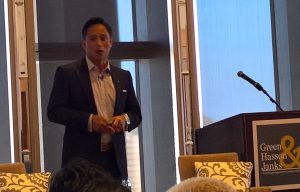 Green Hasson and Janks hosted their third nonprofit conference in Los Angeles. The theme this year focused on their recent report on Nonprofit Risk: Opportunities and Challenges in a High-Risk World. The keynote speaker was Art de la Cruz, COO of Team Rubicon. “Team Rubicon unites the skills and experiences of military veterans with first responders to rapidly deploy emergency response teams.” They are one of my favorite veteran’s organizations.
Green Hasson and Janks hosted their third nonprofit conference in Los Angeles. The theme this year focused on their recent report on Nonprofit Risk: Opportunities and Challenges in a High-Risk World. The keynote speaker was Art de la Cruz, COO of Team Rubicon. “Team Rubicon unites the skills and experiences of military veterans with first responders to rapidly deploy emergency response teams.” They are one of my favorite veteran’s organizations.
Art spoke primarily about Risk and Opportunity. “Risk tolerance is beyond managing risk but looking for opportunity.” Through his career he has used a Risk and Opportunity Matrix as it helps people think about what is and isn’t in their control. It’s about how you maneuver around the grid. This is how he looked at managing risk while in the military. “The other option is to do nothing. If you don’t plan on seizing opportunity, you will be in a challenging situation in the future. It’s like car maintenance, its driving fine now, but if you never change the oil, you will eventually stall.”
He was a lieutenant when he retired after 22 years in the military and was a “Top Gun” pilot. On September 11, 2001, he was on the aircraft carrier USS Enterprise. When the first tower was hit, email was shut down, when the second tower was hit, they stopped dead in the water. They then waited for instructions from the President. He used this as an example of an organization, you are cruising along just fine, but then an external force, or in today’s language a disruption, occurs, you change course. Even if you are changing the direction of something as massive as an aircraft carrier.
He talked of the importance of cognitive diversity. “Bring in different types of experience, and the collective experiences, to the table when making decisions. You can’t manage risk to zero. Determine risk tolerance. Jump through methodical hoops to better achieve mission. And when ideas arise, listen for value, don’t listen for barriers. Find the five words that are really, really good, versus looking for the five words that make the idea a challenge. When looking five years out, are we just going to focus on mitigating risk or are we going to seize opportunity?”
Taking risks is hard. Often it is going against people’s comfort level. Sometimes following popular belief is the easiest route, but does it really lead to new ideas and moving society forward? Art gave a lot of good examples and the new report from Green Hasson and Janks is worth the read even for those outside the nonprofit audience for which it was written. When it comes to taking risks, and being bold, here is one of my favorites quotes, from Henry Ford: “If I had asked people what they wanted, they would have said faster horses.”
